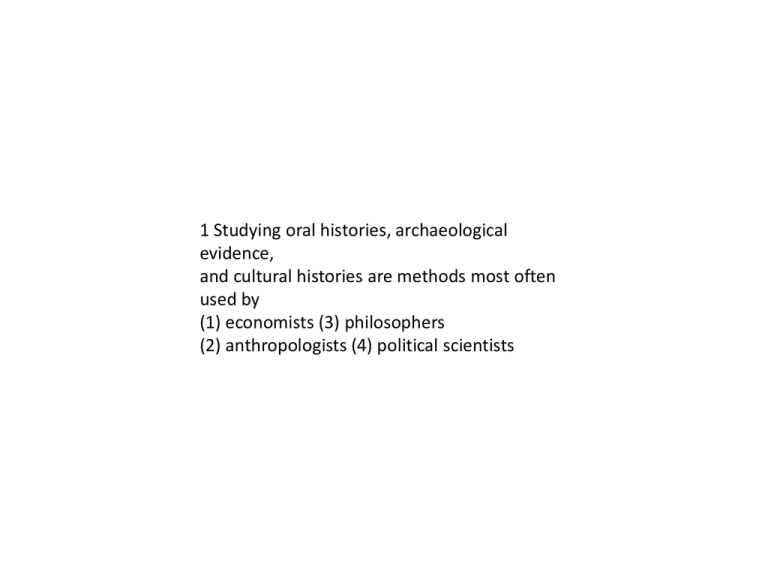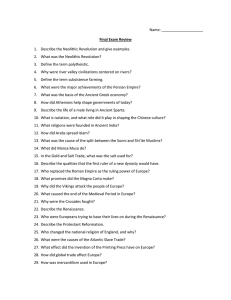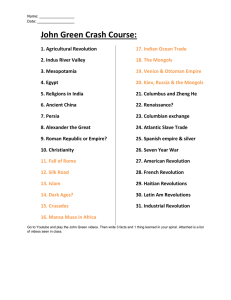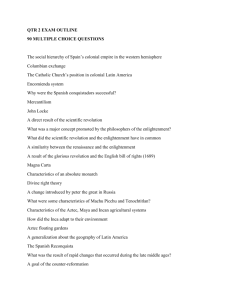Two Treatises of Government - White Plains Public Schools
advertisement

1 Studying oral histories, archaeological evidence, and cultural histories are methods most often used by (1) economists (3) philosophers (2) anthropologists (4) political scientists • 2 When studying ancient civilizations, a geographer • would be most interested in looking at • (1) language as a form of expression • (2) family structure • (3) climatic influences on food production • (4) standards for leadership • • • • 3 Most traditional societies are (1) closely linked to the natural environment (2) located near large urban areas (3) organized around complex economic systems • (4) dependent on manufacturing • 4 One way in which the Huang He, the Indus, and • the Nile civilizations were similar is that they • each • (1) flourished by trading salt and gold • (2) developed monotheistic religions • (3) suffered repeated invasions • (4) originated in river valleys • • • • 5 The Code of Hammurabi and the Twelve Tables were designed to (1) create a stable society (2) promote peaceful relations with other cultures • (3) provide a framework for the development of • democracy • (4) emphasize the importance of life after death • • • • 6 The terms Brahma, dharma, and moksha are most closely associated with which religion? (1) Judaism (3) Hinduism (2) Islam (4) animism • • • • • • • • 7 Constantinople became the center of the Byzantine Empire because (1) the pope had made it the capital of the Christian world (2) it was a religious center for Muslims (3) its location made it the crossroads of Europe and Asia (4) it was geographically isolated from surrounding • empires 8 The principal cause of the trend in England shown in the graph was (1) famine (3) immigration (2) disease (4) a lower birthrate • 11 One way in which the code of chivalry in Europe • and the code of Bushido in Japan were similar is • that both codes were intended to • (1) help the ruler control his people • (2) guide the behavior of a warrior class • (3) benefit all the social classes • (4) support revolutionary ideas • 12 Carefully drawn calligraphy, Zen gardens, and • the tea ceremony are examples of • (1) artifacts of Mansa Musa’s Timbuktu • (2) the accomplishments of the Protestant • Reformation • (3) early Japanese culture • (4) the achievements of Renaissance Florence • 14 During the 1500s, technological advances in • navigation, naval engineering, and mapmaking • contributed directly to the start of the • (1) Gupta Empire (3) Age of Exploration • (2) Mongol Empire (4) medieval guilds • 15 The revival of Greek and Roman culture, the economic • growth of Italian city-states in the 1400s, and • the development of humanism were aspects of the • (1) Age of Revolutions • (2) Protestant Reformation • (3) spread of Islam • (4) European Renaissance • 15 The revival of Greek and Roman culture, the economic • growth of Italian city-states in the 1400s, and • the development of humanism were aspects of the • (1) Age of Revolutions • (2) Protestant Reformation • (3) spread of Islam • (4) European Renaissance • • • • • • • • 17 The success of the triangular trade system depended on increasing (1) political independence of the Caribbean nations (2) emphasis on free trade in European nations (3) slave trade in the Western Hemisphere (4) industrialization of the South American colonies • • • • • • • • 21 Which quotation was most likely made by an absolute monarch? (1) “The government that governs best, governs least.” (2) “I am the state.” (3) “The government must be based on a sound constitution.” (4) “It is the parliament that must make the laws.” • • • • • • • 22 The Glorious Revolution in England resulted in the (1) strengthening of divine right rule (2) formation of a limited monarchy (3) weakening of Parliament’s power of the purse (4) end of civil liberties guaranteed by the Petition of Right • 23 One similarity of the Scientific Revolution and • the Enlightenment is that both • (1) had the support of the Roman Catholic • Church • (2) placed great value on traditional beliefs • (3) emphasized the value of human reasoning • (4) contributed to the end of feudalism • • • • • • • • • • 24 “Americans today, and perhaps to a greater extent than ever before, who live within the Spanish system, occupy a position in society no better than that of serfs destined for labor, or at best they have no more status than that of mere consumers. . . .” This quotation, written in September 1815, represents the views of (1) Martin Luther (3) Simón Bolívar (2) Catherine the Great (4) Adam Smith • • • • • • • • • • • • • • • • • • • 25 “If man in the state of nature is free, if he is absolute lord of his own person and possessions, why will he give up his freedom? Why will he put himself under the control of any person or institution? The obvious answer is that rights in the state of nature are constantly exposed to the attack of others. Since every man is equal and since most men do not concern themselves with equity and justice, the enjoyment of rights in the state of nature is unsafe and insecure. Hence each man joins in society with others to preserve his life, liberty, and property.” — John Locke, Two Treatises of Government, 1690 This statement provides support for the (1) elimination of laissez-faire capitalism (2) formation of government based on a social contract (3) continuation of absolute monarchy (4) rejection of the natural rights philosophy • 26 Which 19th century ideology led to the unification • of Germany and of Italy and to the eventual • breakup of Austria-Hungary and of the Ottoman • Empire? • (1) imperialism (3) liberalism • (2) nationalism (4) socialism • • • • • • • • • • • • 27 “Famine seems to be the last, the most dreadful resource of nature. The power of population is so superior to the power in the earth to provide subsistence for man, that premature death must in some shape or other visit the human race. . . .” — Thomas Malthus, “Essay on Population,” 1798 This prediction proved to be wrong in part because of increases in (1) ethnic cleansing (2) farm productivity (3) the number of wars (4) the number of droughts • Base your answers to questions 28 and 29 on the passage • • • • • • • • • • • • • • • • • below and on your knowledge of social studies. “It was a town of red brick, or of brick that would have been red if the smoke and ashes had allowed it; but as matters stood it was a town of unnatural red and black like the painted face of a savage. It was a town of machinery and tall chimneys, out of which interminable serpents of smoke trailed themselves for ever and ever, and never got uncoiled. It had a black canal in it, and a river that ran purple with illsmelling dye. . . .” — Charles Dickens, Hard Times 28 The author of this passage is describing conditions caused by the (1) Commercial Revolution (2) French Revolution (3) Industrial Revolution (4) Scientific Revolution • • • • • 29 Which problem is the subject of this passage? (1) economic inequality (2) urban pollution (3) lack of child labor laws (4) poor transportation systems • 30 The Meiji Restoration in Japan was prompted in • part by • (1) a fear that Japan would be colonized by • western nations • (2) the failure of Japanese expansion • (3) the Shogun’s conversion to Christianity • (4) a desire to stay isolated • 31 Growing nationalism and militarism in Europe • and the creation of secret alliances were • (1) reasons for the rise of democracy • (2) causes of World War I • (3) requirements for economic development • (4) reasons for the collapse of communism • • • • • • • 33 The Japanese, the Germans, and the Italians pursued a policy of expansionism before World War II to gain (1) natural resources (2) warm-water ports (3) manufacturing plants (4) freedom of the seas • • • • • • • • • • 34 Which statement is most accurate concerning the effect of geography on the history of Poland? (1) Natural barriers have isolated and protected Poland. (2) The northern European Plain has made Poland vulnerable to invasion. (3) Mountains have restricted the diffusion of Polish culture. (4) The absence of seaports has limited Polish economic growth • 35 The Japanese invasion of Manchuria in 1931 and • Hitler’s rebuilding of the German military in 1935 • demonstrate the • (1) success of defensive alliances • (2) fear of communist expansion • (3) support for the Treaty of Versailles • (4) failure of the League of Nations • 36 Which action illustrates the concept of genocide? • (1) the British negotiating peace with Adolf • Hitler during the 1938 Munich Conference • (2) Adolf Hitler and Joseph Stalin signing a • nonaggression pact in 1939 • (3) the Nazi armies eliminating the Jews and • other groups as part of Adolf Hitler’s Final • Solution • (4) German generals plotting against Adolf Hitler • • • • 39 The purpose of the Marshall Plan was to (1) restore Japanese economic development (2) provide military aid to Middle Eastern allies (3) assure nationalist success in the Chinese civil • war • (4) provide for economic recovery in Western • Europe • • • • • • • 40 The Truman Doctrine, Korean War, crisis in Guatemala, and Soviet invasion of Afghanistan were all (1) reasons for the Industrial Revolution (2) examples of Japanese imperialism (3) events of the Cold War (4) causes of World War II • 41 Mikhail Gorbachev instituted the policies of glasnost • and perestroika to • (1) reinforce the basic economic principles of • communism • (2) bring the Soviet Union into the European • Economic Community • (3) reform the Soviet Union politically and economically • (4) gain acceptance for free political elections • 42 During the late 20th century, in which area did • deforestation become a serious problem? • (1) Great European Plain • (2) Amazon Basin • (3) Deccan Plateau • (4) Great Rift Valley • • • • • • • • • • • • • • • • • • • • Base your answer to question 44 on the statements below that appeared in a newspaper in 1998. “In response to the nuclear tests, people in New Delhi took to the streets lighting firecrackers, thanking Hindu gods, and crying out, ‘Bharat Mata Jai!’ (Victory to Mother India).” “President Bill Clinton decided tonight to impose economic sanctions on India’s government for detonating three underground nuclear explosions.” 44 Which statement is supported by these two news excerpts? (1) India is falling behind in the race to develop nuclear weapons. (2) The United States officially supports India’s nuclear weapons program. (3) People in India and the United States have reacted very differently to India’s nuclear test. (4) India’s development of nuclear weapons will improve chances for peace in the region. • 45 The problems created by the deterioration of the • Earth’s ozone layer and increases in the amounts • of acid rain suggest a worldwide need for • (1) rapid industrialization of developing economies • (2) better health-care programs • (3) nuclear-powered electric generating facilities • (4) stricter pollution regulations • 46 Since the 1960s, famine in many parts of the • world has been reduced by • (1) increased urbanization • (2) global warming • (3) laissez-faire capitalism • (4) the Green Revolution • 49 Mahatma Gandhi and Jomo Kenyatta were similar • in that both • (1) supported colonial policies • (2) sought to gain independence from Great • Britain • (3) led a worldwide boycott of British goods • (4) used violent revolution to achieve their aims





